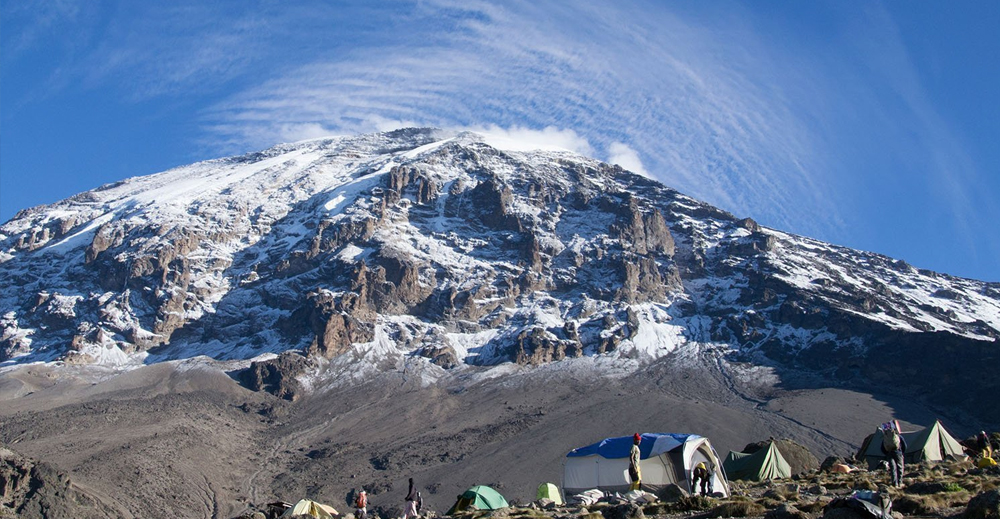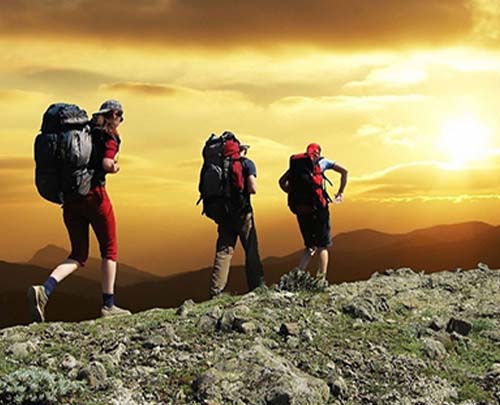CLIMB KILIMANJARO | LEMOSHO ROUTE 7 DAYS/6 NIGHTS
Mount Kilimanjaro is the highest point of Africa standing at three peaks, Kibo which is 5,895 metres, Mawenzi 5,749 meters, Shira 4,160 meters, the mountain is an awesome spectacle, but climbing it is achievable by anyone who is determined and reasonably fit.
There is a number of routes to climb the mountain, of which we recommend four. The Rongai and Marangu are the easiest, while Machame and Shira provide more enduring walk while ascending. The journey to the roof of the mountain takes at least five days and is best attempted during Tanzania’s dry seasons – July through September and January through March.
The dry, warm months from mid-December to March and the dry, but cooler months from June to October are generally the best times to trek on the mountain as the weather is normally more favourable with less rain and snow. November is a little more unpredictable and you can have some beautiful sunny days followed by some very poor weather. The months of April and May should be avoided as it can be very wet with heavy snow and therefore also very cold. The views tend to be that much clearer after the end of the rains as the dust in the air has been swept away, although the views on clear days are breathtaking throughout the year.

It should be noted that weather patterns are changing throughout the world and becoming less predictable, so it is important that you come prepared for poor weather on the mountain at any time of the year. Please contact us for a full information pack with details of our standards of service on the mountain including staff welfare, accommodation, food and general conditions on the mountain.

Kilimanjaro Climbing Tours via Lemosho route

LEMOSHO ROUTE (7 Days - Itinerary)
Day 0 | Pre-trek Briefing
Arrival at Kilimanjaro International Airport (JRO), where you will meet an our representative, and transfer
to the hotel under the rate. The hotel will provide all the essentials for a comfortable stay: cozy rooms,
hot water, polite staff, a swimming pool, and Internet access. In the evening there will be a briefing with
our managers, who will also make sure you are ready to begin the climb.
Note: Check-in starts at 2:00 PM.
Day 1
After breakfast and briefing, drive to Londorossi
Park Gate (about a 3-hour drive). From here a forest track requiring a 4WD vehicle leads to Lemosho Glades. Walk
along forest trails to Mti Mkubwa (big tree) campsite.
Day 2
After breakfast, we continue as the trail gradually steepens and enters the giant heather moorland zone. After several streams are crossed we continue over the Shira Ridge past the Shira 1 camp and on to the Shira 2 camp on moorland meadows by a stream.
Day 3
From the Shira Plateau we continue to the east up a ridge, passing the junction towards the peak of Kibo. As we continue, our direction changes to the South East towards the Lava Tower, called the “Shark’s Tooth” (elev 4650m/15,250ft). Shortly after the tower we come to the second junction which goes to the Arrow Glacier. We now continue down to the Barranco Camp. Although you end the day around the same elevation as when you began, this day is very important for acclimatization and will help your body prepare for summit day..
Day 4
After breakfast, we leave Barranco and continue on a steep ridge up the Barranco Wall to the Karanga Valley and the junction which connects with the Mweka Trail.
Day 5
We continue up to the Barafu Camp. You have completed the South Circuit, which offers views of the summit from many different angles. Here we make camp, rest, enjoy dinner, and prepare for the summit day.
Day 6
Very early in the morning (midnight to 2 am),
we continue our way to the summit between the Rebmann and Ratzel glaciers. You head in a northwesterly
direction and ascend through heavy scree towards Stella Point on the crater rim. This is the most mentally
and physically challenging portion of the trek. At Stella Point you will stop for a short rest and will be
rewarded with the most magnificent sunrise you are ever likely to see. Faster hikers may view the sunrise
from the summit.
From Stella Point, you may encounter snow all the way on your 1-hour ascent to the summit. Once at Uhuru
Peak you have reached the highest point on Mount Kilimanjaro and the continent of Africa!
From the summit we begin our descent by continuing straight down to the Mweka Camp, stopping at Barafu
for lunch. You may want gaiters and trekking poles for the loose gravel going down. We arrive at Mweka
Camp and enjoy our last evening on the mountain.
Day 7
After breakfast we continue the descent down to the
Mweka Park Gate to receive your summit certificates. At lower elevations, it can be wet and muddy. Gaiters and
trekking poles will help. Shorts and t-shirts will probably be plenty to wear (keep rain gear and warmer
clothing handy).
Kili Explorer Tanzanias vehicle will be waiting for you at Mweka gate to drive you back to your hotel in
Moshi or Arusha
.
LEMOSHO ROUTE


Whats included in this tour
- All transfers to the mountain and back to your Moshi hotel
- Professional, experienced, mountain guides
- Guides, Porters, Cook salaries and park fees
- Quality, waterproof, four-season mountain sleeping tents (on twin sharing basis)
- All meals while on the Mountain
- Quality Mess tents with table and chairs
- Large portions of fresh, healthy, nutritious food
- Clean, purified drinking water
- Conservation fees (part of park fees)
- VAT (18% charged by the Government)
- Surcharge for online payment of deposit (5%)
Whats not included in this tour
- Tanzania Visa
- Personal trekking equipment such as sleepings bags, hiking boots, clothes, etc (available for renting)
- Tips and gratuities
- Travel insurance
- Personal Expenses (e.g. laundry, telephone, beverages, etc.)
- Meals not listed in the itinerary
- Liquors, beers and bottled beverages
- Surcharge for online payment of balance (5%)









REQUEST A PRICE QUOTE!
Drop us a line. Our experts will answer all your questions in 24 hours